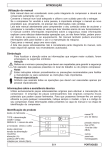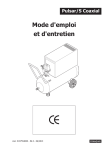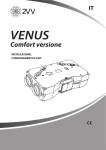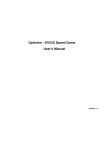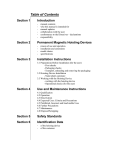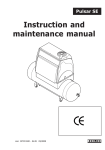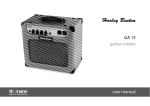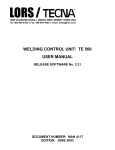Download Pulsar S- coax_GB
Transcript
Pulsar/S Coaxial Instruction and maintenance manual cod. #197554000 - Ed.3 - 06/2013 ENGLISH SUMMARY FOREWORD.......................................................................... 3 1.GENERAL INFORMATION.................................................... 4 2. installation.................................................................. 6 3. START-UP......................................................................... 6 4. maintenance.................................................................. 8 5.troubleshooting..........................................................10 2 FOREWORD Use of the Instruction manual This manual is integral part of this compressor and should be kept for its whole working life. Keep this manual in a safe place so not to damage it. If the compressor is sold to a third party, also give the Instruction Manual to the new Owner. This manual should be carefully read before starting the compressor up and in case of any doubt on its operation. This manual contains important safety information on operation procedures, which should be complied with, otherwise injuries to people or damages to the machine might occur. Important use and maintenance instructions are also mentioned in this manual. Should this manual be lost, please ask for a new copy Spare parts list is not considered as integral part of this manual, since it is available at authorized dealers’ offices only. Symbols The following symbols are used for especially important information: Caution Highlights precautions to be taken to ensure safety of the operator, people in the compressor working area and the compressor. Notes Highlights recommended instructions or precautions to be taken to have an easier maintenance procedure or to explain most important instructions. Specialized personnel Every intervention highlighted by this symbol is exclusively the job of a specialized technician. Technical Assistance Use only genuine spare parts for servicing the compressor. Non-genuine spare parts might cause injuries to people. For efficient Technical Assistance, please always state model, type and part number of Your compressor. Those data are specified both on compressor plate and label on manual cover page. Product identification Manufacturer’s data Name Code Serial number Intake/FAD Noise pressure Pressure Tank capacity RPM Weight TYPE CODE S/N bar = psi = Tank = RPM Kg = L/MIN CFM Lwa = V= Lwa m = Hz = A= kW = Voltage Absorption Power HP = 20.... 3 year of manufacture 1.GENERAL INFORMATION This compressor was designed and manufactured to be used only to deliver compressed air for handicraft and/or industrial applications in full compliance with the safety instructions provided in the following paragraphs. Compressor can be equipped with several accessories for blowing, washing and painting as well as air tools. See the relevant manuals for correct use of accessories and tools. Carefully read the User’s Manual before servicing the compressor. Before performing maintenance work, switch off the compressor and cut off power supply by switching off the wall-mounted switch (if any). What SHOULD BE DONE: • Understand how to stop the compressor at once and become familiar with the use of all controls.• Before any operation the compressor tank should be emptied. Unplug the compressor so to avoid any accidental compressor start. • After any maintenance operation make sure all the disassembled parts are properly assembled. • To have a safe operation, make all checks mentioned in chapter “Start-up” before starting the compressor. • Keep children and animals away from the working area, so as to avoid any injury caused by devices connected to the compressor. • Carefully read the instructions of any tool you have installed, especially if a spray gun is used, make sure the shop is well ventilated before you start painting. • Always start and stop three-phase compressor through the wall switch. • Should the compressor be working around the clock, the use of soundproof headset is recommended. What SHOULD NEVER BE DONE: • Do not paint indoor or close to naked flames. • Never touch cylinder head, cooling fins and delivery tube since they become very hot while working. They are still very hot for some time after stopping the compressor. • Never place inflammable nylon or cloth objects near or/and on the compressor. • Never move the compressor when the tank is under pressure. • Never use the compressor if the power cable is faulty or the connection is not safe. • Never aim the air jet either at people or animals.• Never allow anyone to operate the compressor without giving him/her proper instructions • Never hit flywheel and fans with metal or blunt objects. Compressor might break or be seriously damaged. • Never operate the compressor without an air filter. • Never tamper with the safety valve or the tank. • Never use the compressor in potentially explosive premises. • Never connect the air outlet cock to a tube with a max. capacity which is lower than the compressor capacity. Never run the compressor when temperature is under 0°C (operating temperature range: +5°C / +40°C). 4 1.GENERAL INFORMATION Standard accessories The compressor is supplied with the following accessories: anti-vibrating element or pivoting wheel 2 wheels + assembly pins box key user’s manual oil dipstick (lubricated models) 1 Unpacking and Handling This machine is supplied on a wooden pallet and protected by a top paper cover. 1. Wear safety gloves and cut straps with scissors and withdraw the paper from the machine top. 2. Hoist the compressor using a means with a suitable lifting power 3. Fit the wheels and/or the anti-vibrating elements. Before accepting the delivery, check all machine parts and accessories are included and for the perfect integrity of the machine. Possible objections will not be accepted after delivery acceptance. We recommend the package be kept so that it can be used again in case the compressor is moved. Keep it for the warranty period at least. If needed, it will be easier and safer to pack and send it to the service center. After this period, deliver the package to the authorized organization for its disposal. Compressor description Compressor main components are (fig.2): 2 1. Pressure switch 2. Line cock 3. Safety valve 4. Non-return valve 5. Compressor pump 6.Tank 5 2. installation Placement Upon installation, make sure that the chosen place is in compliance with all prevailing national safety standards and meets the following requirements: • low percentage of dust suspended in air, • shop must be suitably sized and well ventilated so that room temperature never exceeds 40°C when the compressor is working. If this is not the case, install one or more exhaust fans to extract hot air. Ideally, the fans should be installed close to the ceiling. • Leave at least 20 cm between the machine and any object which might obstacle a proper air flow and therefore reduce ventilation and cooling. • Lubricated machines: to be never positioned on slopings over 15°C Power connection The compressor is delivered to the Customer after being successfully tested by the Manufacturer. When purchased is therefore ready for use. Electrical hook-up is of major importance. 3 Before performing any operation is very important to make sure that the voltage mentioned on the compressor label (or on the label on the cover sheet of this manual) complies with the mains voltage and the main switch is on OFF/0 ( fig.3) • Single-phase models Connect the plug to a proper socket. Call only specialized personnel, in case of changes to be made for compliance with the standards of the country in which the compressor is used. • Three-phase models Call a specialized technician for installing a wall switch HP V230 V400 equipped with fuses having values not under the values Hp A A indicated in the relevant table. Install the switch close to the machine cable exitand at operator’s reach. 1,5 5,2 3 2 8 4,6 3 8,6 5 3. START-UP Controls and control instruments 1. 2. 3. 6. 7. 8. 9. Pressure switch (single phase model) built-in pressure switch (three-phase model) Line cock Safety valve Tank pressure gauge Air outlet pressure gauge Pressure reducing valve ON/OFF switch Operation 4 8 2 7 9 6 3 1 The compressor is operated by the pressure switch/built-in pressure switch and stops about a minute later after reaching the allowed max. pressure. During this period the compressor will run without compressing any air so that the compressorbox assembly can be cooled down, whereas the solenoid valve will bleed the air off the final manifold and head, thus favoring next compressor start. 6 3. START-UP A short air blow of some seconds when the compressor stops is therefore a sign of proper compressor operation (this blow cannot be heard during regular use with door closed). As soon as pressure reaches the min. allowed value, the compressor will automatically start. Operating pressure adjustment Check for optimal operating pressure value of the accessory to be used with the relevant manual. Adjust the air pressure at the outlet according to the required value through the pressure reducing valve 8 (fig.4). Turn the knob clockwise to increase pressure and anti-clockwise to decrease. The set value is indicated by the pressure gauge 7 (fig.4).It is recommended the pressure value be zeroed after use so that the pressure reducing valve will not be subject to earlier wear. First start-up Once the compressor has been carefully positioned and connected, it is ready for start-up. It is recommended this operation - operational test - be performed by a specialized technician. Before continuing, make sure that • mains voltage is the same as voltage mentioned in the machine plate; • all connections have suitable cross-section cable (see table) and that cables are neither damaged nor have bare wires; • wall switch is equipped with suitable fuses (see table); • oil level is over the minimum level. After checking the above, proceed as follows: • Power the wall switch on (Three-phase Pulsar). Plug the machine (Single-phase Pulsar); • Start the compressor through the pressure switch/built-in pressure switch (fig. 3); • Allow the motor to run for at least 5 minutes with the air valve open. After that time, close the valve and make sure the compressor is loading the tank and stops after reaching the max. pressure value indicated by the pressure gauge 6 (fig, 4). Never unplug the compressor to stop it but always position either the switch on the pressure switch body or the wall switch to Off. In this way the compressed air in the head will be bled, thus favoring next compressor start. Safety devices Safety valve on the pressure switch/built-in pressure switch: bleeds the air off once the max. safety value has been reached. Motor thermal cutout (fig.5): in case of motor overheating due to some troubles, this device will trip, thus cutting the machine out and avoiding any motor damage. 5 Allow some minutes (about 5) before manually resetting the thermal cutout so that the motor can restart. If the switch trips again on motor restarting, power the machine off. Unplug the compressor and call an authorized service center. 7 4. maintenance General information 6 The compressor should be serviced at regular intervals for a proper operation. Switch the compressor off and bleed all air off the tank before any servicing. After first 100 working hours • Check for proper tightening of all screws, in particular the head screw. • Check for the proper tightening of all pipe fittings. • Check that no dust is inside the box and see whether the installation place is really the right one. Compressor should not be dusty. • Change oil (fully) using one of the safety oil types indicated on page 7. 7 A Condensate drain (weekly) Condensate is drained through the drain valve placed under the tank: Just position a proper container for condensate collection and open the valve by turning counterclockwise. Close the valve when only air starts coming out (fig.6). If your compressor is of the lubricated type, condensate should never be drained into the sewage system since it may be polluant. B Clean air suction filter (monthly) Remove the cover from the top or open the box door using the proper key. Filter types: A) MK160-MK285-VKM320-VKM362 (fig.7-A) These compressor assemblies are equipped with one or two suction filters fitted beside the compressor head. To open the filter, unscrew the middle screw. B) VKM402 (fig.7-B)These compressor assemblies are equipped with one or two suction filters fitted beside the compressor head. To pull out the filtering element just open the bottom door.Wash the sponge element with water and soap. Rinse and dry properly before re-fitting. Close the filter. Never run the compressor if suction filter is not fitted. Should foreign bodies or dust go into the filter, its inner parts might seriously damage. NOTE: CHANGE THE FILTERING ELEMENT AFTER TWO OIL CHANGES. Check and top-up oil (monthly) B A C MAX MIN 8 Remove the cover as indicated in the above paragraph.Withdraw the oil dipstick C and make sure the oil level is within the min. and max. level. Top up through suitable filler B (fig. 8), if necessary. 8 4.maintenance Change oil (every six months) Withdraw the oil dipstick C, unscrew the plug A and deliver the exhausted oil into a container with the help of the suitable detachable sheet fitted between the compressor unit and the tank connection sheet. Screw the plug A and continue as indicated above. Change the oil or top up always when the compressor is still warm. Never mix different types of oil together. Poor oils are not recommended,since they may have unsuitable lubrication properties. OIL SHOULD ALWAYS BE DISPOSED OF IN COMPLIANCE WITH CURRENT LAWS. CALL AUTHORIZED BODY FOR ITS DISPOSAL. Later maintenance • Every 6 months It is recommended to clean all compressor finned parts for an efficient cooling system and therefore a higher machine performance. • Each year Change the filtering element. • Each two years 1. Check and clean delivery and suction valves. 2. Check for proper conditions of the non-return valve and change the gasket A, if necessary (fig. 9). In these cases, it is recommended all seals be changed. 9 9 A 5.troubleshooting Problem Cause Remedy Air leaking off pressure switch Check valve leaking. valve when the compressor is stopped. Bleed air off the tank, remove the check valve cap and clean valve seat and sealing element. Replace the sealing element, if necessary. Air leaking off pressure switch Loadless start valve broken. valve for a long time when the compressor is running. Replace the valve. The compressor stops and Motor overheating, Thermal Allow some minutes (about cannot be restarted. cutout tripped. 5) before manually resetting the thermal cutout. Should the compressor stop once again, call a specialized technician. The compressor stops once Winding burnt. max. pressure has been reached and the safety valve starts working. Call a specialized technician The compressor does not char- Pressure switch defective or Call a specialized technician ge and causes overheating. broken. The compressor is too noisy Heat gasket or valve broken. and rattles. Bearings seizure. 10 Stop the compressor with no delay and call a specialized technician. Stop the compressor with no delay and call a specialized technician.











